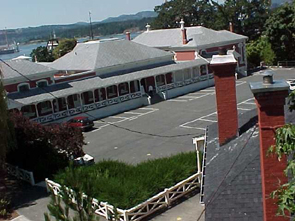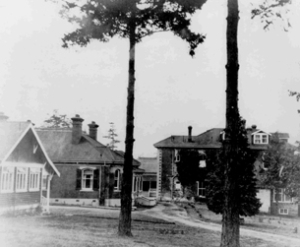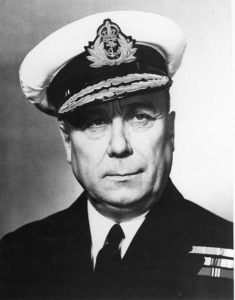The museum at CFB Esquimalt had humble beginnings.

The complex of heritage buildings that houses CFB Esquimalt Naval & Military Museum’s displays and exhibits, viewed from above.
Back in 1977, the entire museum “collection” was contained in a green, two door, metal cupboard at the back of the Base Library stacks. The collection was mainly two-dimensional, comprising papers, books and documents.
Thanks to the formation of a Friends of the Museum Society and other initiatives, and the hard work of its many volunteers, the museum has now grown in size and scope. In 1994, the museum celebrated its grand re-opening at its present location in Buildings 37 and 39, Naden.
The following history of the museum is based on the written recollections of its former curator, Ernie Colwell:
The notion of opening a museum at the Naval Base at Esquimalt may date all the way back to the 1940s. The idea appears to first have been suggested in a Second World War publication, although its not clear if any steps were taken then to make the idea reality.
The next such proposal was made in 1952, during a visit to Esquimalt by His Royal Highness the Duke of Edinburgh (Prince Philip). On his return to the UK, the Prince arranged that a marble bust of Lord Nelson be sent to the fledgling Museum from the Greenwich museum of England. This became the nucleus of the RCN museum at Signal Hill, Esquimalt, which opened to the public in 1955.
Opening ceremonies for the RCN Museum included the Flag Officer Pacific Coast, Rear-Admiral J.C. Hibbard, and the Curator, Cdr. Bill McCully. The Museum at Signal Hill later went through some name changes to become the Maritime Museum of British Columbia, which eventually moved downtown to Bastion Square, Victoria, in 1965.
The building housing the museum was something of a museum piece in itself, having been built originally to house the Royal Engineers when they were stationed at Victoria in the 19th century. The bricks for the structure were brought around the Horn in a sailing vessel.
In the late 1970s, the idea of operating a purely naval museum at CFB Esquimalt was revived, with the help of the Base Historical Committee. Further investigation resulted in the formation of a society with the purpose to collect, preserve and display the history of the Naval Base of Esquimalt.

The complex of heritage buildings that now houses CFB Esquimalt Naval and Military Museum, as it looked in days gone by.
The founder members (1981) were Mr. Guy Copley, Major Robin Alford, Captain Cecil Baker, Mr. F.D.H. (Doug) Nelson and Ernie Colwell. Two other members who were deeply involved were Mr. Jack Rippengale, former superintendent, Fort Rodd Hill, and Mr. Doug Franklin, Director of the National Heritage Trust. This collective of interested individuals later became the CFB Esquimalt Museum and Archives Society.
In Feb 1985, the museum moved to Bldg’s 20(N) and 29(N) at Naden. There was an impressive opening on May 5 1985, the 75th Anniversary of the Navy, but the museum was still very much in need of a collection in order to create meaningful exhibits. The work of assembling a meaningful collection continued, and the museum, then located in Building 20 at Naden, was opened to the public in 1987.
In 1994, further expansion and improvements, including the addition of displays devoted to the defence of Canada’s West Coast, led to the grand re-opening of the museum in its present location, Buildings 37 and 39 at Naden.


